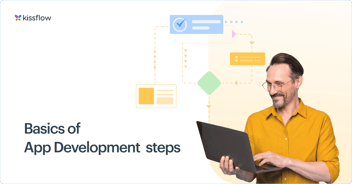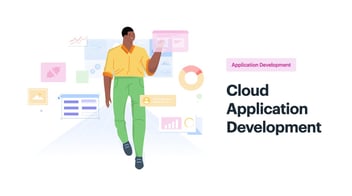Bringing your groundbreaking web app idea to life is crucial to its potential success. In today's digital age, web applications are essential for businesses to communicate with customers, fulfill internal operations, and stay ahead of the competition.
It's crucial to streamline and simplify your app development process through standardization and efficient practices to ensure your app's success.
In this blog, we'll explore the key approaches to successful app development platform and take your vision from concept to reality.
Types of application development approaches
App development approaches are crucial in shaping the success of a web application. The right approach can determine the development process's speed, scalability, and cost-effectiveness. Today, there are a variety of approaches to choose from, ranging from low-code and no-code to microservices and serverless architecture.
Waterfall Development
Waterfall development is a traditional, structured approach ideal for projects with stable requirements and clear deliverables. Each phase, such as planning, design, coding, testing, and deployment, flows sequentially, ensuring no overlap. It works best for industries like construction, manufacturing, or highly regulated sectors where changes are minimal and detailed documentation is crucial. However, its rigidity can make adapting to unforeseen changes challenging, potentially leading to delays and cost overruns.
Agile Development
Agile is a flexible and collaborative methodology that delivers software incrementally through short development cycles called sprints. It emphasizes continuous feedback from stakeholders, allowing teams to adjust quickly to changes. Agile fosters better alignment between business needs and development efforts, reducing the risk of misaligned goals. While ideal for dynamic and evolving projects, Agile requires strong communication and a disciplined approach to deliver value consistently.
Low-Code and No-Code Platforms
Low-code and no-code platforms are making rounds in app development by making it accessible to both developers and non-technical users. Low-code platforms simplify coding with visual interfaces and pre-built modules, while no-code platforms enable complete app creation without any programming knowledge. They are perfect for automating business processes, creating prototypes, and clearing IT backlogs. Despite their speed and simplicity, these platforms may not suit highly complex or enterprise-critical applications requiring custom coding.
Rapid Application Development (RAD)
RAD accelerates the development process through iterative prototyping and close user collaboration. It bypasses lengthy planning phases by focusing on building and refining functional models early. This approach reduces risk by validating features incrementally and adapting quickly to user feedback. RAD is particularly effective for projects with tight deadlines or when the exact requirements are not fully defined at the start.
Progressive Web Apps (PWA)
PWAs bridge the gap between websites and mobile applications, offering offline functionality, faster load times, and a consistent user experience across devices. They are built with web technologies but behave like native apps, providing features such as push notifications, home screen installation, and offline access. PWAs are cost-effective alternatives to native apps, ideal for businesses wanting to enhance mobile engagement without heavy investments in platform-specific development.
Serverless Computing
Serverless computing eliminates the need for managing infrastructure by offloading server provisioning and scaling to cloud providers. Developers only need to write code, while the provider automatically handles scaling and resource allocation. This approach is highly cost-effective, as you only pay for what you use, and it is ideal for applications with variable workloads, such as event-driven applications, data processing, or APIs. However, debugging and vendor lock-in can be potential challenges.
Microservices Architecture
Microservices architecture decomposes applications into independent, loosely coupled services, each responsible for a specific business capability. This modular approach enables teams to work on services concurrently, speeding up development and deployment. Microservices are highly scalable and fault-tolerant, as each service can be scaled or updated independently. It is best suited for large, complex applications requiring frequent updates or scaling but can introduce challenges in managing inter-service communication and deployment complexity.
Hybrid App Development
Hybrid apps combine web technologies (HTML, CSS, JavaScript) with native platform capabilities to create cross-platform applications. These apps run within a web view but can access device features through native plugins, offering a balance between performance and cost-effectiveness. Hybrid development is ideal for businesses targeting multiple platforms with a single codebase, reducing development time and costs. However, achieving optimal performance and a native-like user experience can require additional effort.
Learn more: App development platform for small business
Industry trends and impact
The rise of cloud computing has significantly impacted web application development. Cloud providers offer a wide range of services, making it easier for businesses to build, deploy, and manage applications at scale.
Additionally, the adoption of microservices has become increasingly popular, allowing for easier management of complex applications and improved scalability.
Another trend in web app development is the increasing use of artificial intelligence and machine learning to provide personalized experiences, improve performance and provide insights into user behavior.
Progressive Web Apps (PWAs) are also on the rise, providing an app-like experience to users without needing an app store. PWAs are becoming an attractive option for businesses looking to reach users on desktop and mobile devices.
Key criteria for selecting the right approach
When it comes to app development, there are a variety of approaches to choose from. However, ensuring that your chosen approach meets the following essential requirements is critical.
Ease of use: The development approach should be user-friendly and easy for developers and non-technical users.
Drag-and-drop functionality: A drag-and-drop interface can significantly simplify the development process, making it easier for non-technical users to build applications.
Scalability: The development approach should support the application's growth and be scalable as the user base grows.
UI/UX: The user interface and user experience should be intuitive, providing a seamless experience to users.
Integrations: The development approach should allow seamless integration with other applications and services.
User adoption: The development approach should be user-friendly, making it easier for users to adopt and use the application.
Cost: The development approach should be cost-effective, providing value for money.
Learn more about application development tools
Experience seamless app development with Kissflow: The premier no-code/low-code platform
Kissflow cleans up the messy middle of internal operations by getting the right apps made by the right people on the right platform. With Kissflow’s simple low-code/no-code work platform, you can build enterprise applications in weeks.
Some of the key features include drag-and-drop design, a range of pre-built templates and modules, and the ability to integrate with other tools and systems.
Businesses can easily create apps within minutes to manage processes such as HR onboarding, leave management, project management, etc., with 200+ customizable templates. With the low-code/no-code approach, organizations can encourage business users to quickly and easily develop and deploy their own apps without depending entirely on the IT teams.












